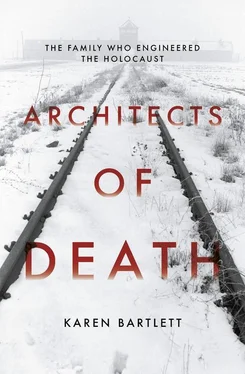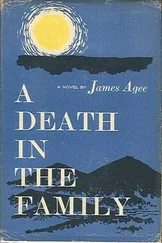Two of the four men who were charged, Max Machemehl and Paul Erdmann, had certainly known about Topf and Sons’s relationship with the SS and the supply of crematoria and gas chamber ventilation equipment to the camps. Charges against the other two, Herbert Bartels (the director of Topfwerke VEB) and commercial assistant Wilhelm Gleitz seem less explicable.
Nonetheless, all four were immediately dismissed from the company without notice and their files passed to the criminal police. Here again, however, the case stalled. The police officer in charge of the case insisted that nothing would come of the matter as the Soviets had no interest in it, and sure enough the investigation was halted in mid-February 1951.
All the men were released from custody on 23 February, but the case had at least succeeded in proving Erdmann’s involvement and knowledge of Topf and Sons’s actions. Erdmann had always maintained that he never supplied installations to Auschwitz, and that there was no correspondence on this matter. A search of his office for the investigation in 1950 proved otherwise. Investigators discovered a signed letter to the SS Reichsführer construction management Auschwitz, the copy of an operating manual for mass extermination systems and a drawing showing the feed between the gas chambers and the ovens.
Max Machemehl – immortalised in Topf’s sixtieth anniversary celebration booklet as the man in the upstairs office who knew everything about the running of Topf and Sons – also steadfastly maintained that he knew nothing about the ‘technicalities’ of the supplies to the SS:
‘Technical matters were dealt with solely by Department D… So far as orders for cremation facilities were concerned, I was merely informed that such orders existed.’ He had nothing to conceal, he added, ‘because the connections were not known to me’. Challenged by the police officer leading the investigation about why he had not turned his back on Topf and Sons when he discovered they were supplying ovens to the concentration camps, Machemehl replied: ‘If I had known back then what we found out after the war about the crematoria in the concentration camps, then I wouldn’t have hesitated – I would have given up my job at once, in keeping with all my decades of conscientious conduct in all aspects of business life.’ [141] Schüle, op. cit., pp. 320–21. AS footnote 153: Record of the interrogation of Max Machemehl by the Erfurt Volkspolizei [People’s Police], 27 November 1950, ThHStAW, National Socialist archive of the Ministry of State Security Object 9 ZA 1492, B. 16r.
After the Erfurt case was closed, and the four men had been released, the state prosecutor replied to the inquiry from Wiesbaden stating, untruthfully, that the investigation was still ongoing and that they had secured statements from Topf oven fitters claiming that they had repeatedly asked to be removed from working on the installations in the camps – but that these requests had been rejected by the Topf brothers. The Wiesbaden prosecutor responded to this letter, asking to see copies of the statements as they were of considerable importance in determining ‘whether or not the accused knew of the criminal purpose for which the cremation ovens supplied to the concentration camps were to be used’. Although the Erfurt prosecutor general instructed the office to send these statements to Wiesbaden, they were never delivered.
In an interim report of 6 June 1951, the Wiesbaden prosecutor, Dr Konig, stated that they were unable to demonstrate that Ernst Wolfgang Topf had had dealings with the SS at Buchenwald, or other camps, or that he knew about the criminal use of the ovens.
Without access to the SS files at Auschwitz that documented correspondence between the camp and Topf and Sons, witness statements from camp survivors, or the Soviet interrogation reports for Kurt Prüfer, Fritz Sander or Gustav Braun, the investigation largely accepted Ernst Wolfgang’s version of events. On 10 June 1952, the criminal case against him was officially closed, with the prosecutor noting that ‘it had not been possible to disprove the accused’s claim that he had never dealt with technical matters and had not been informed about the real purpose of the cremation ovens supplied to the Buchenwald camp’. [142] Schüle, op. cit., p. 324. Quote on closure of criminal case: ‘it had not been possible to prove…’ AS footnote 166: Ministry of Justice of the State of Hessen, file ref. V-90/62, sheet 17; see also the Register of Criminal Investigations at the Wiesbaden Public Prosecution office, HHStAW [Hessen State Archive, Wiesbaden], section 468, no. 1211.
Topf and Sons’s copies of the files detailing their work with the SS have never been discovered. While the controversial amateur historian Jean-Claude Pressac (more of whom later) claimed that Kurt Prüfer had disposed of the files prior to his arrest, Annegret Schüle suggests that Ernst Wolfgang Topf actually passed the files to the American CIC at the end of the war – before they mysteriously disappeared. Even without the files, the evidence of what Topf and Sons had done was always in plain sight – the Topf name was branded across the ovens in iron letters, and Buchenwald survivors testified to the role Topf and Sons played in building the crematoria. Yet the American forces seemed relatively disinterested in Topf and Sons, perhaps because they were so overwhelmed by the horrors that they had seen in the camp and the other, more obvious, perpetrators of war crimes.
With the conclusion of the case, Ernst Wolfgang Topf was free from the prospect of a life in prison. The long-drawn-out denazification case, which was followed by criminal proceedings, had done nothing to deter him from trying to re-establish his business in West Germany – and he demonstrated that he intended to restart Topf and Sons using a patent for the ‘process and device for the incineration of bodies, carcasses and parts thereof’. [143] Ibid., p. 328. Quote from the new patent application: ‘process and device for the incineration of bodies…’ AS footnote 184: German Patent Office, German patent T 1562 V/24d, 24.6.1950; see also ThHStAW, Collection Jean-Claude Pressac Nr. 25, sheets 3–11, 35f, 42f, 51–56.
This patent was not, as is sometimes reported, based on the techniques Topf and Sons employed, or had planned to employ, in the ovens of the concentration camps. But the very fact that a new company run by Ernst Wolfgang was intending to make money from ‘carcass incineration’ outraged Holocaust survivors and the families of victims.
In December 1947, Topf applied for a business permit in Wiesbaden and opened an engineering office in Recklinghausen, hiring an engineer and some shared work space in a wooden barracks. From the outset, the company focused on furnace and oven construction, as Ernst Wolfgang probably surmised that a lack of capital would make it more difficult to break into the bigger malting and storage businesses. There is no doubt that Topf planned to recreate an almost exact replica of the business he’d presided over in Erfurt, even wanting to assign the same departmental letters, including the infamous Department D for oven construction and furnace constructions. A 1953 brochure proudly proclaimed ‘Seventy-five years of Topf’ ovens, which were ‘of first-class quality’ and ‘the product of long years of experience’.
Yet, although some of these ovens were sold to civic crematoria in West Germany during the early 1950s, the new Topf company struggled under insurmountable debts. Soon the company office and Topf’s family home were relocated in an unsavoury part of town in nearby Mainz, where potential customers were put off by having to run the gauntlet of ‘prostitutes, ex-offenders and drunks’ to get to the office entrance.
Читать дальше












